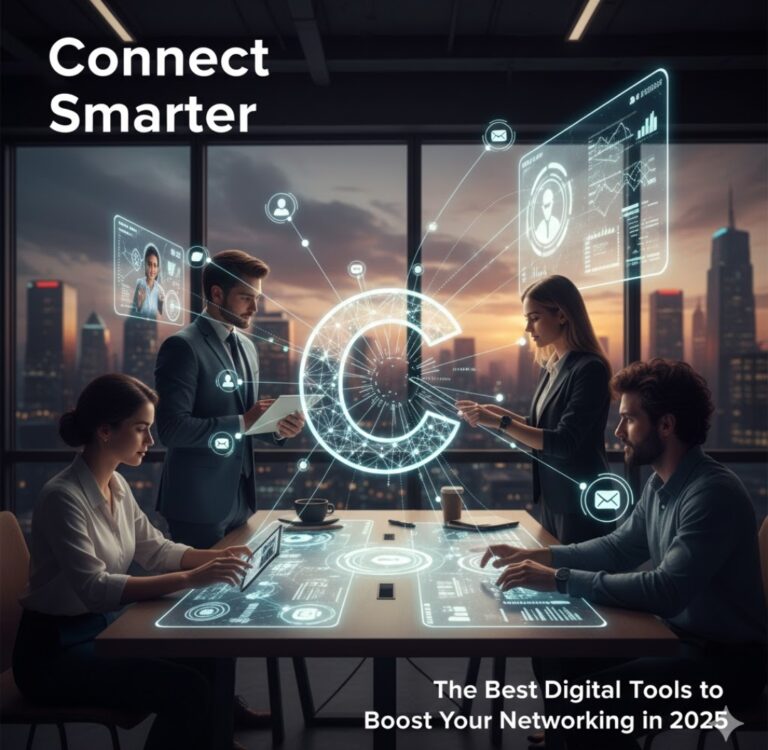In a world where professional connections can open doors faster than ever, networking is no longer just about business cards and firm handshakes—it’s about leveraging digital tools that help you build and maintain meaningful relationships. From LinkedIn optimization to virtual business card design, the right apps and platforms can make your outreach more personal, polished, and productive. Whether you’re a freelancer, entrepreneur, or corporate professional, these tools can help you strengthen your network and grow your opportunities.
1. LinkedIn: The Powerhouse of Professional Networking
No list of networking tools would be complete without LinkedIn, the gold standard for professionals. More than just a resume hub, LinkedIn allows users to showcase thought leadership, join industry groups, and connect directly with potential collaborators, mentors, or employers. With features like LinkedIn Live, you can host virtual events or share insights in real time, while the Creator Mode helps boost your visibility to a larger audience. Customizing your profile URL and adding multimedia elements—such as videos and articles—can further enhance your professional brand. When used strategically, LinkedIn becomes more than a platform—it becomes a launchpad for career growth.
2. Shapr: Networking That Feels Like a Dating App
If traditional networking feels awkward, Shapr turns it into something fun and intuitive. Think of it as “Tinder for professionals.” You create a brief profile outlining your goals and interests, then the app suggests relevant connections nearby. You swipe right to connect with professionals who align with your field or aspirations. The simplicity of Shapr makes it perfect for entrepreneurs, freelancers, and creatives looking for casual yet valuable connections. Plus, the app encourages real-life meetups once a digital rapport is established—bridging the gap between online networking and authentic relationships.
3. Lunchclub: AI-Powered Networking That Works for You
For busy professionals, Lunchclub offers a more intelligent approach to networking. Using AI, the platform matches you with like-minded professionals based on your goals—whether you’re seeking mentors, investors, or potential clients. You simply indicate your interests, availability, and career focus, and Lunchclub schedules one-on-one virtual or in-person meetings. The curated connections save time and increase the chances of meaningful interactions. It’s networking without the randomness, helping you grow your circle with people who actually matter to your career trajectory.
4. Slack Communities: Conversations that Build Collaboration
While Slack is often viewed as a workplace communication tool, it has evolved into a hub for professional communities and niche groups. From marketing experts to developers, there are thousands of Slack communities dedicated to networking, collaboration, and knowledge sharing. These channels allow you to participate in discussions, share projects, and get feedback from peers. By joining industry-specific groups, you can stay informed about trends while organically building your reputation. Slack offers a more casual, conversational approach to networking that feels natural and authentic.
5. Eventbrite: Finding Networking Events that Matter
Virtual or in-person, professional events remain one of the best ways to expand your network. Eventbrite makes it easy to discover industry-specific gatherings, conferences, and workshops. You can filter events by location, category, or theme, and even create your own events to attract like-minded professionals. The platform integrates with calendars and social media, helping you share and promote events effortlessly. For those looking to take networking offline—or blend it with online promotion—Eventbrite offers the perfect balance between accessibility and community engagement.
6. Adobe Express: Creating a Memorable First Impression
When it comes to making connections that last, first impressions count. Adobe Express helps professionals design stunning visuals, from social media introductions to digital resumes and personal portfolios. With its drag-and-drop interface, you can create branded materials that represent your professional identity. Whether you’re crafting a presentation, updating your LinkedIn banner, or designing a business card, Adobe Express ensures your visuals look polished and cohesive. For anyone serious about leaving a lasting impression, this tool combines creativity and professionalism in one easy-to-use platform.
💼 FAQ: Making Networking Tangible with Printed Business Cards
Even in a digital age, physical business cards remain a timeless networking essential. They serve as both a professional courtesy and a tangible reminder of your brand. The right printing service can help you create cards that are as memorable as your first conversation. Below are some common questions professionals ask about designing and printing business cards that make an impact.
Q1: What are the best platforms for creating and printing custom business cards?
Several online platforms make it easy to design and print cards quickly. Adobe Express offers a professional business card print online feature that lets you personalize layouts, fonts, and color palettes. Its templates are ideal for both corporate professionals and creative freelancers looking for modern, customizable designs.
Q2: Which services provide user-friendly customization tools?
Vistaprint and Moo are popular for their intuitive design interfaces. Vistaprint offers a wide range of pre-made templates, while Moo is known for its luxurious paper quality and unique options like rounded corners or glossy finishes. Both platforms make customization accessible, even for users with no design background.
Q3: What platforms offer the best value for professional-quality printing?
If you’re looking for affordability without sacrificing quality, GotPrint and Zazzle are solid options. They provide competitive pricing and often run bulk-order discounts for professionals or small businesses. Their preview tools ensure you know exactly how your cards will look before printing.
Q4: Which companies are known for premium designs and packaging?
Moo stands out with its sleek packaging and premium materials, making it a favorite among executives and creative entrepreneurs. Their Printfinity feature lets you print a different design on every card—perfect for showcasing a portfolio or product range.
Q5: Are there any services that integrate AI or design assistance?
Yes—many modern platforms, including Adobe Express and VistaCreate, now include AI-assisted design features. These tools suggest layouts, color combinations, and font pairings based on your brand style, saving time while ensuring professional results.
Networking has evolved beyond handshakes and conferences—it’s now a dynamic blend of online engagement and real-world interaction. Tools like LinkedIn, Lunchclub, and Adobe Express make it easier than ever to connect, collaborate, and leave a lasting impression. And while digital connections drive most professional growth today, a thoughtfully designed business card still bridges the gap between virtual and personal. By combining modern tools with timeless etiquette, you can expand your network, showcase your expertise, and open the door to endless new opportunities.
Disclaimer: This article is for general information only. We do not give professional advice. The tools and services mentioned are examples and not endorsements. Always do your own research before using any product or service.





